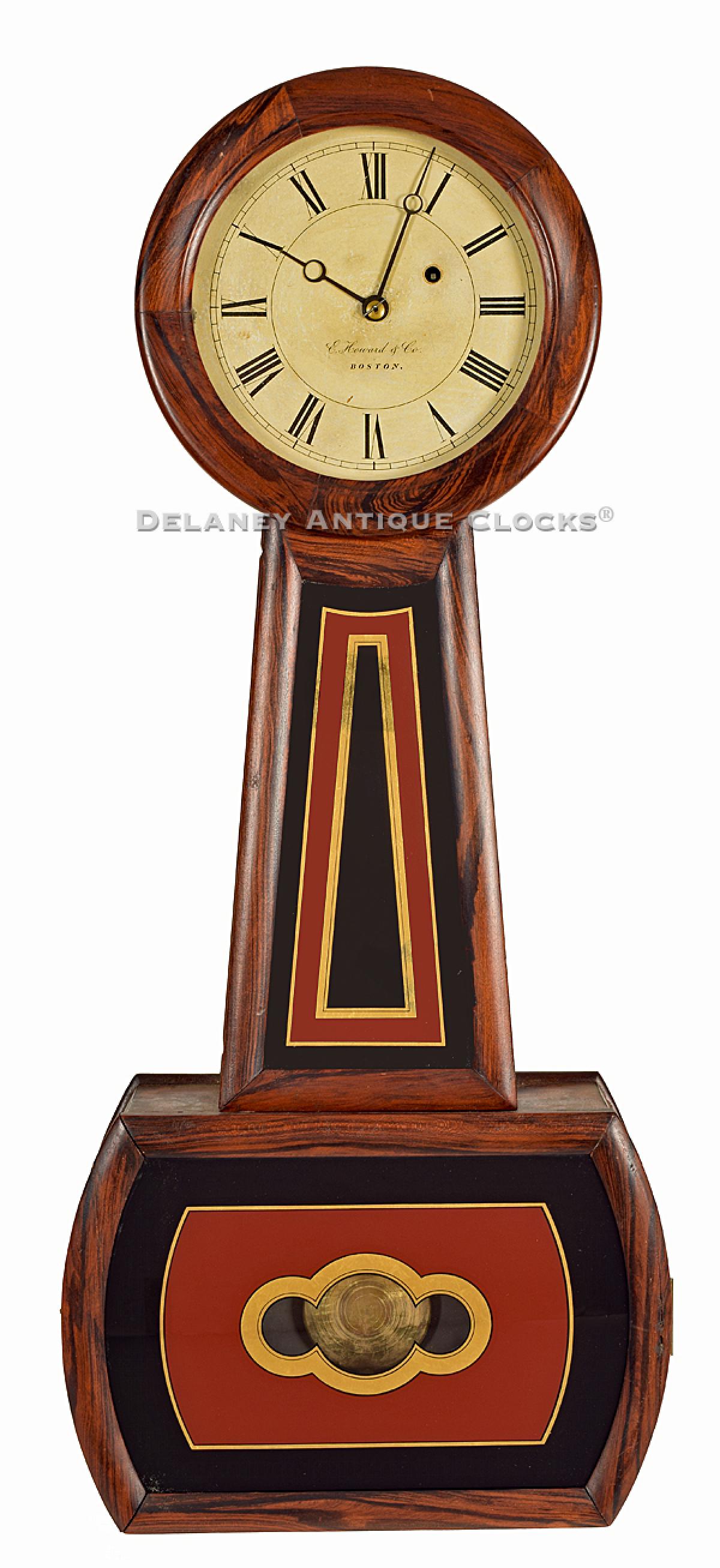E. Howard & Co. Boston, Massachusetts. Wall clock No. 4 with an A. Howard stamped movement. BBB-13.
This is an outstanding example of an E. Howard Model Number 4. It was made by the E. Howard & Company of Boston, Massachusetts, circa 1860. This unusual example features a movement that is die-stamped by Albert Howard.
Albert Howard was born in Hingham, Massachusetts, on May 20, 1833, the youngest of five children. He was a cousin of Edward Howard's, and at the age of 16, he trained in the clock and balance factory of Howard & Davis. In fact, he spent most of his working career involved with the various Howard Clock Companies. At the age of 22, he is listed in the Massachusetts Census as a clockmaker living in Roxbury. In 1857-58, he is listed in the Boston Directories as a clock and balance maker located at 109 Washington Street. It is interesting to note that this is also the same address Samuel Curtis and Edward Howard used as their address this year. In 1858, he was again listed but as a "Clockmaker at Edward Howard's." He married Susan Kingman in Boston on May 11, 1859. In 1881, Albert became the general manager of the E. Howard Watch & Clock Company was also appointed to the board of directors. Albert died of apoplexy in his home located at 13 Brook Ave in Roxbury on January 1, 1893.
Several wall clock examples are known to be signed by this Maker. A small number of clocks signed Howard & Davis and E. Howard are found with his die-stamp on the movement.
This model is the second smallest of the five banjo sizes this company offers. It measures a very manageable 32 inches in length. As a comparison, the smallest example of this set is the No. 5, and that clock measures 29 inches long. The No.1, the largest of the five banjo forms, measures a full 50 inches in length.
This case has very pleasing proportions. It is constructed in cherry and retains its original vibrantly formatted grain-painted decoration. This grain pattern was done in ink to simulate the bold grain patterns found in rosewood. The finish is quite nice and could possibly be original. It has taken a darker tone, and the surface can be best described as being heavy. The original shellac has slightly broken down. The rounded frames are fitted with glass. The two lower panels are decorated or painted from the back in the traditional E. Howard colors of black, gold, and red. The bezel is fitted with clear glass. This protects the paper dial. This model features a paper dial that measures 8 inches in diameter. The company's name is signed in script. The place location is printed in block lettering.
The movement is made of brass and is of excellent quality. It weight driven and features a recoil escapement. It is considered to be an accurate timekeeper. The movement is die-stamped on the front plate, "A. HOWARD / BOSTON." It is powered by the original cast iron weight and is designed to run for eight days on a full wind. The pendulum rod is wood and supports a bass-faced lead bob. This bob is decorated with a concentric ring-turned design. Every other ring retains its original damascene design. This is a very good bob.
This example was made circa 1860.
Inventory number BBB-13.
The E. Howard & Company succeeded the Howard & Davis firm in 1857. The Howard & Davis firm was comprised of Edward Howard and David Porter Davis and was established in 1842 in Roxbury, Massachusetts. Both men had just completed their clock apprenticeship under the guidance of Aaron Willard Jr in Boston. The Howard & Davis firm made high-grade clocks, precision balances, sewing machines, fire engines, and watches. After the dissolution of Howard & Davis, Edward Howard became Boston's leading manufacturer of weight-driven residential and commercial clocks. The firm also made a large number of tower clocks and watchman and salve clock systems. These sold well in the last quarter of the 1800s.
It has been said that the E. Howard Clock company never made an inexpensive clock, and everything they made was of very good quality. As a result, Howard clocks have become very collectible and are prized by their owners. Today, the E. Howard name enjoys outstanding name recognition.
For a more in-depth reading of Edward Howard and his various businesses, please read "Willard's Patent Time Pieces," written by Paul Foley.








